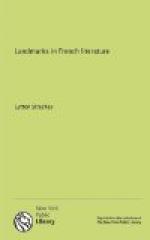one; and it is possible that the value of the Academy
as a centre of purity and taste has been at least
balanced by the extreme reluctance which it has always
shown to countenance any of those forms of audacity
and change without which no literature can be saved
from petrifaction. All through its history the
Academy has been timid and out of date. The result
has been that some of the very greatest of French
writers—including Moliere, Diderot, and
Flaubert—have remained outside it; while
all the most fruitful developments in French literary
theory have come about only after a bitter and desperate
resistance on its part. On the whole, perhaps
the most important function performed by the Academy
has been a more indirect one. The mere existence
of a body of writers officially recognized by the
authorities of the State has undoubtedly given a peculiar
prestige to the profession of letters in France.
It has emphasized that tendency to take the art of
writing seriously—to regard it as a fit
object for the most conscientious craftsmanship and
deliberate care—which is so characteristic
of French writers. The amateur is very rare in
French literature—as rare as he is common
in our own. How many of the greatest English writers
have denied that they were men of letters!—Scott,
Byron, Gray, Sir Thomas Browne, perhaps even Shakespeare
himself. When Congreve begged Voltaire not to
talk of literature, but to regard him merely as an
English gentleman, the French writer, who, in all
his multifarious activities, never forgot for a moment
that he was first and foremost a follower of the profession
of letters, was overcome with astonishment and disgust.
The difference is typical of the attitude of the two
nations towards literature: the English, throwing
off their glorious masterpieces by the way, as if they
were trifles; and the French bending all the resources
of a trained and patient energy to the construction
and the perfection of marvellous works of art.
Whatever view we may take of the ultimate influence
of the French Academy, there can be no doubt at all
that one of its first actions was singularly inauspicious.
Under the guidance of Cardinal Richelieu it delivered
a futile attack upon the one writer who stood out head
and shoulders above his contemporaries, and whose
works bore all the marks of unmistakable genius—the
great CORNEILLE. With the production, in 1636,
of Corneille’s tragedy, Le Cid, modern
French drama came into existence. Previous to
that date, two main movements are discernible in French
dramatic art—one carrying on the medieval
traditions of the mystery-and miracle-play, and culminating,
early in the seventeenth century, with the rough,
vigorous and popular drama of Hardy; and the other,
originating with the writers of the Renaissance, and
leading to the production of a number of learned and
literary plays, composed in strict imitation of the
tragedies of Seneca,—plays of which the
typical representative is the Cleopatre of




